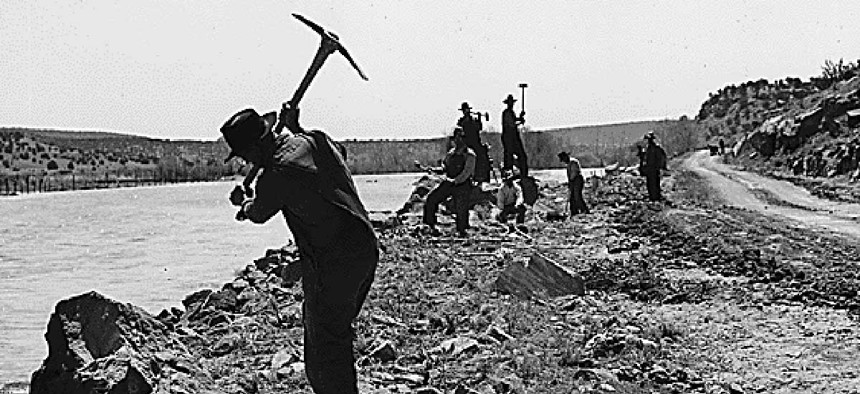The Economic Case for a New WPA
When the government pays for people to work, they get out of poverty, a new study finds.
The social worker Harry Hopkins was convinced of one thing during the Great Depression: It did not benefit a man to sit around waiting for work.
“Give a man a dole,” he famously said at the time, “and you save his body and destroy his spirit. Give him a job and you save both body and spirit.”
Tapped by FDR to put those words into action, Hopkins headed the Civil Works Administration, and then the Works Progress Administration, which spent millions putting 8.5 million Americans to work painting murals, and building roads and bridges.
Subsidized employment programs still exist, but not to the degree that they did in Hopkins’s day. During the recession, the stimulus bill authorized $1.3 billion for subsidized employment programs in 39 states. But that programs is ending, even though the need still exists. There are 2.2 million people in the country who have been jobless for 27 weeks or more (the standard measure for long-term unemployment), and millions who aren’t counted as unemployed because they’ve stopped looking for work. They include older workers, those with criminal records, refugees, and the homeless. Many of these people depend on shrinking government relief or have fallen out of the safety net entirely. But they would work, if only they could find a job.
Creating more subsidized employment programs like the ones that ran during the Great Depression and the recession could be big step in boosting incomes and helping the people at the bottom of the income ladder, according to a studyreleased this week by the Center on Poverty and Inequality at Georgetown. In a review of four decades of academic research on the outcomes of dozens of subsidized employment programs, the writers find that there is a strong consensus: Programs that provide people with temporary jobs, childcare, and healthcare can be essential in getting people into the workforce.
Subsidized employment programs “really help get money into the pockets of some of the hardest-hit families,” said Indivar Dutta-Gupta, the director of the Project on Deep Poverty at the center.
Dutta-Gupta and his colleagues studied the results of dozens of such subsidized employment programs over the course of 40 years and came away with the conclusion that such programs can be extremely effective in getting people into the job market and helping them stay there. Though the upfront cost of such employment programs might be high, they save the government money eventually because they help people get off the dole and earning wages that they spend in the economy and pay taxes on. Over time, Dutta-Gupta and his co-authors find, subsidized employment programs have improved the school outcomes of workers’ children and lowered criminal-justice-system involvement among participants.
The researchers evaluated dozens of programs that ran for various periods of time from the 1970s to today, serving different populations and putting them at work in different industries. Evaluations of one, the AFDC Homemaker Home Health Aide program, which ran between 1983 and 1986 and trained welfare recipients as home health aides and then gave them 12 months of subsidized employment, showed that earnings and employment of participants had improved two years after the program began. In New Hope for Families and Children, run out of Milwaukee, low-income people seeking full-time work received an earnings supplement, subsidized health insurance, and subsidized childcare, in addition to subsidized employment. Eight years after the program, researchers found positive effects on earnings, employment, poverty, marriage rates, mental health, child achievement, and behavior.
“Work isn’t the answer to everything but it is the answer to most problems that people have,” David Riemer, who created New Hope, told me in a phone call.
Another program, Center for Employment Opportunities, which I visited this winter, gives formerly incarcerated people a five-day pre-employment class, subsidized positions in work crews around New York, professional development, and help with work placement.
“You’re earning a daily paycheck, and all of a sudden you’re getting on the subway, with that metro card that you couldn’t afford two weeks ago and you're reading the paper, and you’re sort of like, ‘Yea, I can do this,’” one participant told me.
The authors suggest making subsidized employment programs a permanent part of employment policy. Like most government programs, such a resource wouldn’t go unused.
“Whenever subsidized employment programs are created, there’s substantial interest in participating,” Dutta-Gupta said. “There’s always more people willing to work than there are jobs open.”



